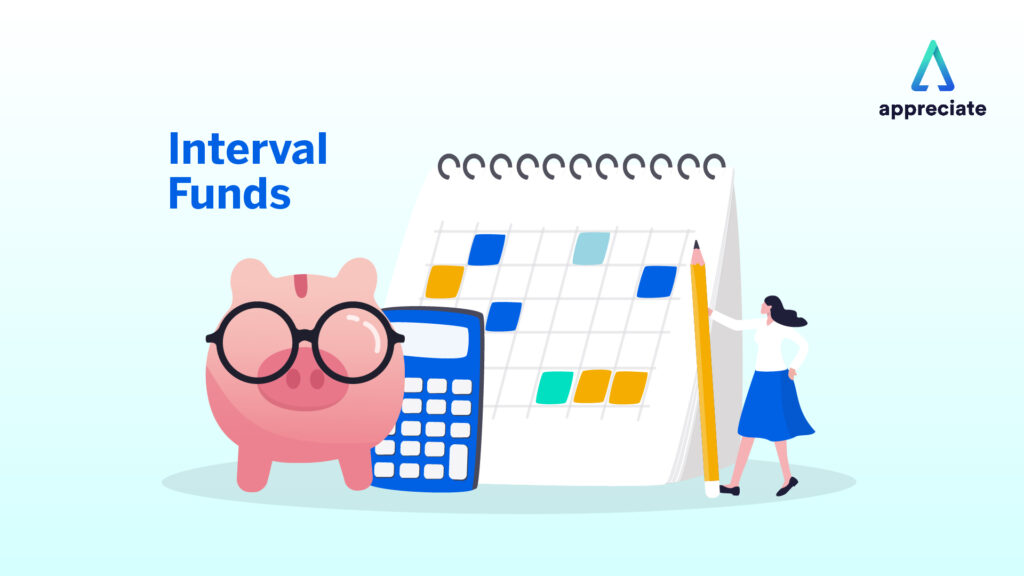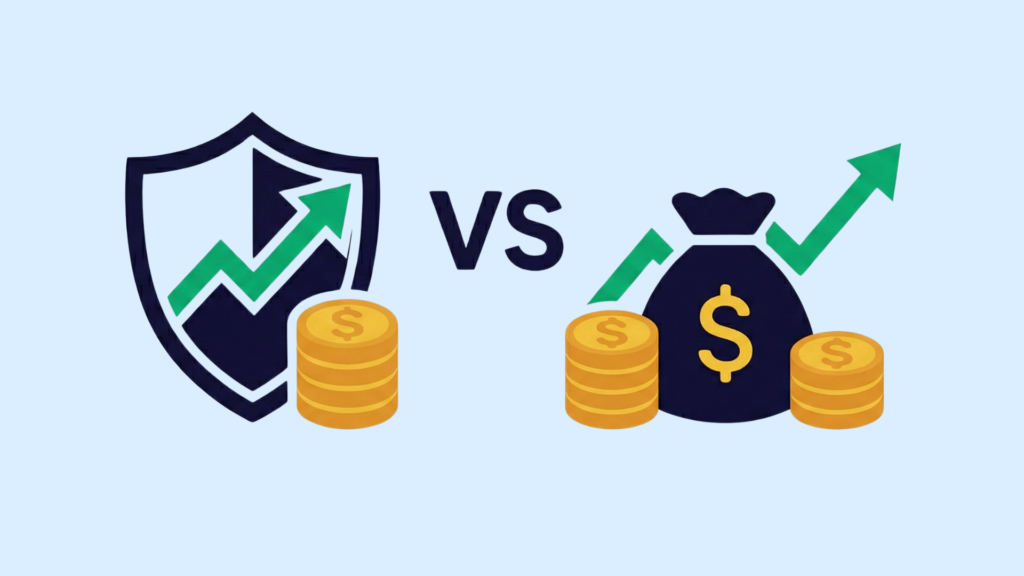Interval funds are a hybrid investment option that combines elements of open-ended and close-ended mutual funds. These funds allow you to invest or redeem units only during specific predetermined intervals, making them less liquid than open-ended mutual funds but more structured than close-ended ones.
In this article, we will share the features, advantages, and taxation rules for interval funds, helping you understand their suitability for your financial goals. Keep reading!
What Are Interval Funds?
Interval funds are a type of mutual fund that allows you to buy or redeem units only during specific time windows, known as intervals, which are set by the fund house. These intervals can be monthly, quarterly, or even annually, providing periodic liquidity.
Unlike traditional mutual funds, interval funds do not trade daily on the stock market, making them less liquid. Instead, they offer the opportunity to buy and sell shares only during the declared periods at the prevailing Net Asset Value (NAV).
Also read: Direct vs Regular Mutual Funds | What is AMU in Mutual Funds?
How Do Interval Funds Operate?
Here’s a more elaborate explanation of how interval funds operate:
Subscription and Redemption
You can only buy or redeem units of interval funds during the designated windows. Outside these windows, the fund is closed to transactions, making it less liquid than open-ended funds, where you can trade daily. This lack of daily liquidity allows for a more stable investment environment.
Investment Strategy
Interval funds may invest in both equities (stocks) and debt instruments (bonds), depending on the fund’s goal. This strategy allows the fund to balance risk and return, catering to investors who are willing to lock in their money for a specific period while aiming for higher returns than typical open-ended funds.
Fund Management
Interval fund managers have more flexibility in managing the portfolio since they don’t need to worry about daily redemption requests. This enables them to focus on long-term investments and choose securities that may offer higher potential returns but require more time to mature, such as illiquid or alternative assets.
Also Read: What are Liquid Funds | Difference Between Stocks and Bonds
Key Features of Interval Funds
Interval funds are unique mutual funds that combine characteristics of open-ended and closed-ended funds. Here are its key features:
Hybrid Structure
Interval funds integrate the features of both open-ended funds and closed-ended funds. While they remain closed to transactions outside specified periods, you can trade units during designated intervals, providing a balance of flexibility and structure.
Pre-Defined Redemption Periods
You can only redeem your investment during specific time windows declared by the fund. This scheduled redemption minimises the risk of sudden outflows, making it easier for fund managers to maintain long-term investment strategies.
NAV-Based Transactions
Purchases and redemptions occur at the prevailing Net Asset Value (NAV) during the allowed intervals. NAV reflects the market value of the fund’s assets, ensuring fair pricing for all transactions.
Diversified Portfolio
Interval funds often invest in a mix of equity, debt, and other securities. This diversified approach helps balance risk and returns, appealing to investors with varying risk appetites.
Lock-in Period Between Intervals
During the lock-in period, you cannot buy or redeem units. This structure ensures that funds remain stable, enabling fund managers to focus on long-term investments without liquidity concerns.
Also Read: Hybrid Mutual Funds | Debt Mutual Funds
Advantages of Investing in Interval Funds
Interval funds offer a structured approach to investing that appeals to various investor profiles. Some of the primary advantages of investing in Mutual Funds are:
Reduced Volatility
The restricted trading periods mean interval funds are less influenced by short-term market fluctuations. This makes them a stable option for investors looking to avoid frequent market ups and downs.
Disciplined Investment Approach
Fund managers are not constantly pressured to meet daily redemption requests. This allows them to focus on a long-term strategy, potentially leading to better portfolio performance over time.
Potential for Higher Returns
By balancing investments between equity (shares of companies) and debt (fixed-income securities like bonds), interval funds aim to provide steady and potentially higher returns compared to pure equity or debt funds.
Low Redemption Pressure
Since investors can redeem units only during specific intervals, fund managers are not required to keep large amounts of cash on hand. This allows more of the fund’s capital to be invested for growth.
Suitable for Specific Financial Goals
Interval funds are well-suited for medium to long-term financial goals, such as saving for a home or children’s education. They also provide periodic liquidity, giving you access to your investments during predefined intervals.
Also Read: NFOs in Mutual Funds | Equity Mutual Funds
Disadvantages of Interval Funds
Apart from these pros, there are also some disadvantages of interval funds that you should be aware of, such as:
Limited Liquidity
You cannot redeem your investments whenever you like. Redemptions are only allowed during specific intervals set by the fund, making these funds less flexible compared to open-ended options.
Potential Lock-In Periods
Between the redemption intervals, your investments are locked in. This means you might need to hold your units for an extended time, which could be challenging if you need quick access to funds.
Market Risks
The performance of interval funds depends on the underlying assets in the portfolio, such as equity or debt. These assets are subject to market risks, meaning returns are not guaranteed and could fluctuate.
Higher Expense Ratios
Interval funds may have higher management fees due to the active management required and the costs of managing periodic liquidity. These fees could impact your overall returns.
Also Read: Growth Mutual Funds | Income Fund
Taxation of Interval Funds
The tax treatment of interval funds depends on their portfolio composition—whether they are equity-oriented or debt-oriented. Let’s understand this in more detail.
Equity-Oriented Interval Funds
If the fund invests at least 65% of its portfolio in equity instruments, it is treated as an equity-oriented fund for tax purposes. Here are the tax implications:
|
Type of Gain |
Holding Period |
Tax Rate |
|
Long-Term Capital Gains (LTCG) |
More than 1 year |
10% on gains above ₹1 lakh |
|
Short-Term Capital Gains (STCG) |
1 year or less |
15% |
Debt-Oriented Interval Funds
Funds that invest at least 65% in debt instruments are considered debt-oriented. Here are the tax implications:
|
Type of Gain |
Holding Period |
Tax Rate |
|
Long-Term Capital Gains (LTCG) |
More than 3 years |
20% with indexation benefits |
|
Short-Term Capital Gains (STCG) |
3 years or less |
Added to your income and taxed as per slab |
Make sure to review the fund’s portfolio composition and consult a tax advisor to understand how interval funds fit into your financial plan.
Also Read: ELSS Mutual Fund | TREPS in Mutual Funds | How to Invest in Mutual Funds
Who Should Invest in Interval Funds?
Interval funds cater to a specific group of investors with unique financial goals and risk preferences. If you fall into any of the following categories, these funds might be a good fit for you.
Investors Seeking Periodic Liquidity
If you require occasional access to your funds but are comfortable with the limited liquidity offered by interval funds, this investment could work for you. This is because redemption is only allowed during predefined intervals, making it important to plan withdrawals in advance.
Medium to Long-Term Investors
Interval funds are ideal if you have financial goals that span several years. The structured lock-in periods encourage a disciplined approach, aligning well with medium to long-term investment strategies.
Investors Looking for Balanced Risk and Returns
These funds typically offer a mix of debt and equity investments, making them suitable for individuals seeking a balanced risk-return profile. The diversification can help reduce risk while aiming for steady growth over time.
Also Read: Corporate Bonds | What is CAGR in Mutual Funds | Mutual Fund Expense Ratio
How to Invest in Interval Funds?
Now that you have a good understanding of how interval funds operate and its benefits, here’s how you can invest in these funds:
Identify the Right Fund
Start by researching funds that match your investment objectives, such as risk tolerance and financial goals. Also, consider factors like the fund’s asset allocation, historical performance, and management strategy.
Understand the Redemption Windows
Review the fund’s prospectus carefully to know the specific intervals for redemption and purchase. This step is important as it helps avoid surprises about liquidity restrictions.
Apply During the Subscription Period
Invest during the new fund offer (NFO) or subsequent open intervals when purchases are allowed. This is the only time you can buy units of an interval fund.
Track Your Investments
Monitor the fund’s performance and net asset value (NAV) regularly. Also, check its alignment with your financial goals and make adjustments if needed during the next subscription window.
The Bottom Line
Interval funds offer a unique hybrid structure, combining features of both open-ended and closed-ended funds. They provide periodic liquidity, a balanced risk-return profile, and disciplined management, making them suitable for medium to long-term investors with specific financial goals.
However, their limited liquidity and potential lock-in periods require careful consideration of your investment needs and risk tolerance.
If you’re considering interval funds, Appreciate is the best trading app that can provide personalised investment strategies and expert insights, helping you align your portfolio with your goals
Download the Appreciate trading app now!.
FAQs about Interval Funds
How do interval funds differ from open-ended and closed-ended mutual funds?
Unlike open-ended funds, interval funds allow purchases and redemptions only during specified intervals, but they are not traded on stock exchanges like closed-ended funds
Can I redeem my interval fund investment anytime?
No, you can only redeem your investment during the predefined redemption windows. These intervals are mentioned in the fund’s prospectus.
What are the advantages of interval funds?
Interval funds offer periodic liquidity and a diversified portfolio of equity and debt instruments. Due to limited trading, they also benefit from reduced volatility.
What are the risks associated with interval funds?
The primary risk is limited liquidity, as you can only access your funds during the redemption periods. Additionally, depending on the underlying assets, they are subject to market risks.
How are interval funds taxed?
Taxation depends on the fund’s portfolio composition. For instance, equity-oriented funds follow equity tax rules, while debt-oriented funds are taxed as debt instruments.
Who should consider investing in interval funds?
Investors seeking periodic liquidity and medium to long-term investment options can consider these funds. They are also suitable for individuals looking for a balance between risk and returns.
What is the typical lock-in period for interval funds?
The lock-in period is the duration between redemption intervals, which varies by fund. It can range from a few months to a year or more, as stated in the fund’s terms.
How do I choose the right interval fund for my portfolio?
Before selecting a fund, assess your financial goals, risk tolerance, and investment horizon. Also, research the fund’s past performance and portfolio composition to make an informed decision.
Are interval funds suitable for long-term goals?
Yes, interval funds can align with long-term goals if their redemption intervals and investment strategy fit your timeline. Their balanced approach can provide stable returns over extended periods.
|
Here are more investment opportunities for stocks and shares that might interest you. |
|
Disclaimer: Investments in securities markets are subject to market risks. Read all the related documents carefully before investing. The securities quoted are exemplary and are not recommendatory.























